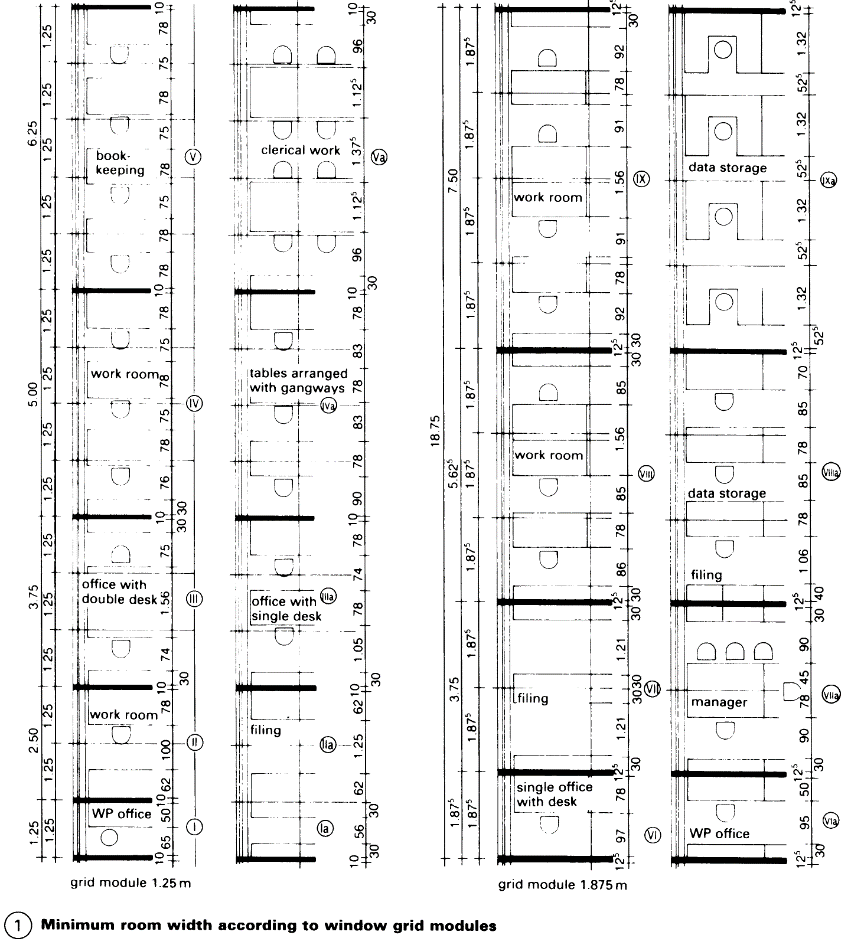Calculations: Floor Area Requirements
Office area requirements are calculated in two parts.
1. People space is calculated as (standard individual space x number of people) + allowances for immediate ancillary needs + a factor (usually 15%) for primary circulation.
2. Non-people space (e.g. machine rooms, and libraries and the like for which fittings and equipment sizes are more important than staff numbers in setting the area requirement) should be calculated by informed estimates based on existing good practice or comparable examples + an additional factor for primary circulation.
Figures for the average floor area requirement for each workstation and employee in an organisation (including office equipment and space to operate it), not including management, have roughly the following distribution:
30% 3.60-4.60 m2
55% (average 8.5 m2) 7.00-9.00m2
15% >9.00-15.00m2
The space requirement per employee clearly depends on a number of factors, e.g. type of work, use of equipment and machinery, degree of privacy, level of visits made by outsiders and storage needs. The average workstation floor area requirement until 1985 was 8-10m2; in future it will be 12-15m2. Although a minimum floor area requirement for office workstations has not been defined, the following guidelines should be followed: separate offices, minimum 8-10m2 (according to the grid module); open-plan offices, minimum 12-15m2
A representative calculation of the space requirement for a workstation is as follows:
work room, min. 8.00m2 floor area;
free circulation space, min. 1.5m2 per employee, but min. 1 m wide;
surrounding volume of air, min. 12m3 when most work is done while seated, min 15m3 when most work is done while not seated.
The following floor-to-ceiling heights are recommended for floor areas of:
up to 50m2 2.50 m
over 50m2 2.75 m
over 100 m2 3.00 m
over 250 and up to 2000 m2 3.25 m
An American study (Connecticut Life Insurance) indicates the following requirements for floor area and space to operate office equipment (personal floor area + an additional 50cm on all sides):

The depth of a room depends on the space required for an individual in a multi-occupant, open-plan, group or office room. The average depth of office space is 4.50-6.00 m. Daylight illumination reaches work workstations to a depth of approx. 4.50m from the window (depending on the location of the office building, e.g. in a narrow street or in an open area). Rule of thumb: D = 1.5HW, where D is the depth of light penetration and Hw is the height of the window head (e.g. Hw = 3.00m, D = 4.50m). Workstations located in the deepest third of the room require artificial light. Working groups often have to do without daylight penetration, since they may be allocated to deeper rooms if that is required by the building layout.
The width of corridors depends on the occupation of the space and the area required to move equipment. Generally speaking, it should be possible for two people to pass each other.
According to standard dimensions relating to the varied space requirements in office buildings, the minimum distance between the centre lines of windows or window columns is 1.25m. The resulting distances between the centre lines of partitions are 2.50m, 3.75m, 5.00 m etc. – (I) –(V). These offer considerable choice in positioning furniture, and are flexible enough to fulfil almost every requirement. If a larger module is needed, the spacing shown in (II) should be selected.

The largest grid module for office buildings is 1.875m; the figure- (VI) – (IX) shows some examples of the many efficient ways to position furniture. Beam spacing according to the standard dimensions of 625mm or 1.25m is also suitable for this centre distance, and every third beam will coincide with a facade column.
Usable floor area is based on the principle of office units arranged in a row along the fagade or some variant thereof, with office size determined by rank or function.

1.20 m grid module. The standard room size of 18 m2 (3 x 1.20m less 0.10m for the partition) corresponds to a 3.50m room width, which is too narrow for standard furnishings for two employees (2 x 1.00m clearance plus 2 x 0.80 m depth of desk = 3.60m). The two-grid-module room, 2.30m wide, is too narrow for one senior staff member with seating for a visitor. Deeper workstations with video display units and other special equipment require the next largest room (4.70m).
1.30 m grid module. A room 3.80 m wide, corresponding to 18m2 usable floor area, allows for an additional filing cabinet, two video display stations 0.90 m deep, one drawing table or drawing machine and one desk, and one desk and conference table for four people. Such an office is very flexible, and will accommodate workstations of all standard office sizes without any need to move the walls.
1.40 grid module. A room 4.10m wide, i.e. 3 x 1.40m less 0.10m for a partition, provides excellent possibilities for furnishing and more flexible use. A room depth of 4.40m, providing 18m2 floor area (i.e. 4.10m x 4.40m), is normally sufficient for special uses or greater demands on space. Increasing the room depth to 4.75 m increases the usable floor area of a three-grid-module standard room to 19.5m2 (i.e. 4.10m x 4.75m).
Date added: 2023-01-05; views: 891;
